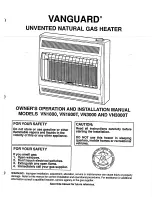
S
AFETY
Electric Tankless Water Heater •
3
T
o reduce the risk of property
damage, serious injury or death,
read and follow the precau ons below,
all labels on the water heater, and
the safety messages and instruc ons
throughout this manual.
General Requirements
•
Install and properly ground the
unit in accordance with local
codes, or in the absence of local
codes, with the current edition
of the National Electrical Code:
ANSI/NFPA 70 in the USA or
CSA standard C22.1 Canadian
Electrical Code, Part 1 in Canada.
•
Follow all applicable plumbing,
heating, and air conditioning
codes during installation.
RISKS DURING INSTALLATION
AND MAINTENANCE
WARNING
Electric Shock Risk
Contact with the electrical
parts inside the water heater
can result in severe injury or
death from electrical shock:
•
Disconnect power by opening the
circuit breaker(s) before installing
or servicing.
•
SOME MODELS ARE CONNECTED
TO MORE THAN ONE BRANCH
CIRCUIT, AND MORE THAN ONE
DISCONNECT SWITCH MAY BE
REQUIRED TO DE ENERGIZE THE
EQUIPMENT.
ALL BRANCH CIR
CUITS MUST BE DISCONNECTED
PRIOR TO SERVICE.
• Use a non-contact circuit tester to
confirm that power is off before work-
ing on or near any electrical parts.
•
Be sure the cover is reinstalled and
secured after servicing to reduce
the risk of fire and electric shock.
RISKS DURING OPERATION
WARNING
Scalding Risk
This water heater
can make water hot
enough to cause
severe burns instantly, resulting in
severe injury or death.
•
Feel water before bathing or
s howering.
•
To reduce the risk of scalding,
install Thermostatic Mixing
Valves (temperature limiting
valves) at each point of use.
These valves automatically mix
hot and cold water to limit the
temperature at the tap. Mixing
valves are available at your local
hardware store or from your
plumbing supplier. Follow the
manufacturer’s instructions for
installation and adjustment of the
valves.
•
For all models, the temperature
set point is factory set to 120°F
to reduce the risk of scalding.
Exception: single chamber (point-
of-use) models are factory set to
approximately 105°F.
•
Higher temperatures increase
the risk of scalding, but even at
120°F, hot water can scald. If you
choose a higher temperature,
Thermostatic Mixing Valves
located at each point of use are
particularly important to help
avoid scalding.
Temperature Time to Produce a
Serious Burn
120°F (49°C)
More than 5 minutes
125°F (52°C)
1½ to 2 minutes
130°F (54°C)
About 30 seconds
135°F (57°C)
About 10 seconds
140°F (60°C)
Less than 5 seconds
145°F (63°C)
Less than 3 seconds
150°F (66°C)
About 1½ seconds
155°F (68°C)
About 1 second
For information about changing the
factory temperature setting, refer to
“Water Temperature Adjustment” on
page 15.
Even if you set the water heater set
point to a low se ng, higher tem-
peratures may occur in certain circum-
stances:
• Water temperature will be hotter if
someone adjusted the temperature
set point to a higher setting.
• If the water supplied to the water
heater is pre-heated (for example,
by another water heater), the tem-
perature of the water may be high-
er than the temperature set point.
• Problems with the UIM (user
interface on two- or four-chamber
models) or other malfunctions may
result in higher than expected water
temperatures.
To reduce the risk of unusually hot wa-
ter reaching the
fi
xtures in the house,
install Thermosta c Mixing Valves at
each point of use.
If anyone in your home is at par cular
risk of scalding (for example, the el-
derly, children, or people with disabili-
es) or if there is a local code or state
law requiring a certain water tempera-
ture at the hot water tap, then these




































